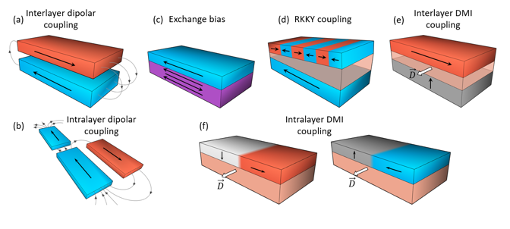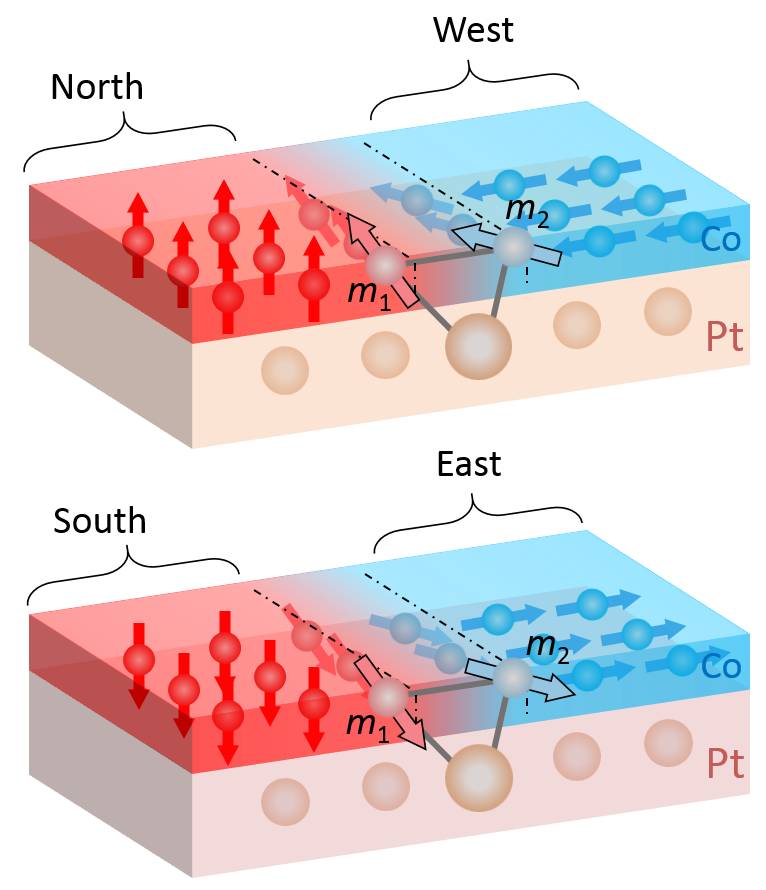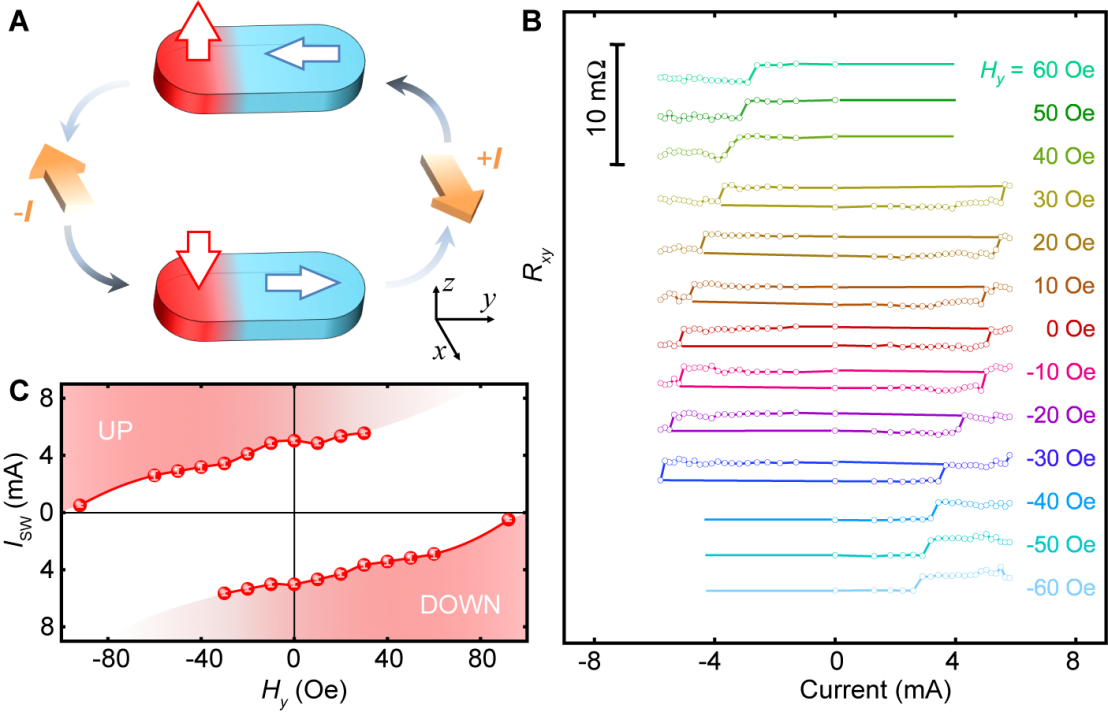Chirally coupled nanomagnets
Synthetics magnets
Synthetic magnets are assemblies of interacting magnetic elements whose dimensions, position, and properties can be tuned to determine how they respond to external stimuli, such as magnetic fields and electric currents. The ability to engineer assemblies of nanoscale magnets is central to the development of different technologies, such as magnetic sensing, recording, and cloaking. At the microscopic scale, synthetic arrays of magnets with dimensions ranging from micrometers down to a few tens of nanometers can be designed to obtain magnetic configurations with a well-defined hierarchy of energy levels and degeneracies that is determined by the competing dipolar interactions among the elements of the array. These microscopic arrays are extensively investigated for a wide range of uses including nanomagnetic logic gates, magnetic metamaterials, magnetic micromachines, and artificial spin ices.

Figure 1 shows an overview of the different interactions that can be used to realize synthetic magnets. The dipolar interaction is the oldest and better known one, as it is responsible for the familiar attraction between north and south poles of two magnets. Exchange bias and RKKY coupling are quantum mechanical interactions that are widely employed to tune the magnetic hysteresis of spin valves and magnetic tunnel junctions used in sensing and data storage devices. Following the emergence of the Dzyaloshinskii–Moriya interaction (DMI) in thin film magnetism, new routes have been opened to couple the nanomagnets via strong chiral interactions, which is complementary to the established dipolar and exchange coupling mechanisms. The DMI can be used to engineer arrays of magnets with dimensions ranging from micrometers down to a few tens of nanometers that have a well-defined hierarchy of energy levels and magnetic orientations. These microscopic arrays are investigated for a wide range of uses including nanomagnetic logic gates, magnetic metamaterials, magnetic micromachines, and artificial spin ices. For more information about these systems please read below.
A new way to couple magnets
All magnets have both a North and South magnetic pole. When two magnets are brought near each other, like poles repel, whereas opposite poles attract. We learn these fundamental laws of physics as children and rarely question them thereafter. The attraction between North and South poles helps travelers find their way around the world using a magnetic compass, underpins the functioning of electric motors, and enables data storage in hard disk drives, to cite just a few of the many applications of magnets. But is it always true that North and South poles that attract each other? The answer is yes, at least in magnets we can see. However, when the dimensions of the magnets approach the nanometer scale, that is, dimensions comparable to the length scale of the interactions among atoms, unexpected things happen.

In collaboration with the research team of Prof. Laura Heyderman at the Paul Scherrer Institute and Department of Materials at ETH Zurich, we have shown that there are special pairs of nanomagnets that tend to align with the North pole of one magnet pointing West of its neighbor or, equivalently, with the South pole of one magnet pointing East of the other. This peculiar type of interaction is achieved by careful tuning of the magnetic properties in a nanometer thick cobalt layer sandwiched between a noble metal layer (platinum) and an oxide layer (alumina). While the so-called magnetic anisotropy causes the atomic moments (the spins) to point either in the plane or out of the plane in the Co layer, the asymmetric surface environment favors the orthogonal alignment of the spins with a specific chirality, namely North-West and South-East, as schematically shown in Fig. 2. The origin of this chiral coupling is traced back to an interaction postulated more than 60 years ago by physicists Igor Dzyaloshinskii and Toru Moriya, who argued that this explains the weak ferromagnetism of hematite, which would otherwise have zero net magnetization. As shown by the PSI-ETH collaboration, the Dzyaloshinskii-Moriya interaction has a prominent role in nanomagnets, leading to magnetic patterns that are much more complex than the simple parallel ordering typical in ferromagnetic materials. These unusual patterns, such as the North-West and South-East alignments, open new opportunities to tailor the coupling of arrays of nanomagnets for fundamental investigations as well as spintronic devices.

Scientists have investigated the coupling between nanoscale magnetic elements for many years, not only out of shear fascination with magnets, but also because structures consisting of coupled magnetic layers are central to the functioning of magnetic sensors and non-volatile memories. Indeed, the 2007 Nobel prize discovery of the giant magnetoresistance effect, which enabled a tremendous increase of sensitivity and reduction in size of magnetic sensors, was a result of the discovery of another type of unusual magnetic coupling, which favors either parallel or antiparallel alignment between two ferromagnetic layers depending on the thickness of a nonmagnetic spacer layer placed between them. Following this discovery, substantial efforts have been made to engineer different types of coupling between nanomagnets. Until recently, however, the most effective couplings have been found to occur between the magnetic layers in a vertical stack. The discovery of the joint PSI-ETH team, on the other hand, is a lateral coupling of nanomagnets placed next to each other, providing a platform to design planar magnetic networks with unprecedented properties and functionalities. Some of the unusual magnetic structures that can be created using North-West and South-East alignments are so-called synthetic antiferromagnets, namely arrays of ferromagnetic dots alternately pointing North and South that are bridged by a West-East spacer, as well as synthetic skyrmions, namely topologically nontrivial swirling magnetization textures, and artificial “spin ice” checkerboard patterns. Figure 3 (Top left: Synthetic antiferromagnetic chain consisting of ferromagnetic cobalt dots with alternate North/South orientation (red) mediated by West/East segments (blue). Top right: Synthetic skyrmions with arbitrary number of windings. Bottom left: Extended checkerboard pattern of laterally coupled nanomagnets forming two different types of domains (green and purple shading). Bottom right: Kagome pattern of laterally coupled nanomagnets with frustrated interactions.) shows some examples of synthetic magnets as measured by x-ray photoelectron microscopy at the Swiss Light Source. These structures host a multiplicity of magnetic states that can be addressed and manipulated by electric currents, as shown in Fig. 4, which is another key result of the PSI-ETH study.

Combined with all-electric synchronous switching, lateral coupling opens a route for the realization of nanomagnet logic gates and memory devices as well as for the design of electrically reconfigurable magnonic crystals, which can be used to manipulate the propagation of spin waves in synthetic media or provide a controlled modulation of the magnetic stray field in hybrid materials, such as ferromagnet/semiconductor and ferromagnet/superconductor heterostructures. We are now actively working to realize prototype demonstrators of all-magnetic nonvolatile logic gates by cascading arrays of laterally coupled nanomagnets on electrical tracks.
Selected publications
- Field- and current-driven magnetic domain-wall inverter and diode, Z. Luo, S. Schären, A. Hrabec, T. P. Dao, G. Sala, S. Finizio, J. Feng, S. Mayr, J. Raabe, P. Gambardella, and L. J. Heyderman, Phys. Rev. Applied 15, 034077 (2021). Downloadarticl (PDF, 5.2 MB)vertical_align_bottom
- Chiral coupling between magnetic layers with orthogonal magnetization, C. O. Avci, C.-H. Lambert, G. Sala, and P. Gambardella, Phys. Rev. Lett. 127, 167202 (2021). Downloadarticle (PDF, 823 KB)vertical_align_bottom, Downloadsupplementary information (PDF, 1.6 MB)vertical_align_bottom
- Current-driven magnetic domain-wall logic, Z. Luo, A. Hrabec, T. P. Dao, G. Sala, S. Finizio, J. Feng, S. Mayr, J. Raabe, P. Gambardella, L. J. Heyderman, Nature 579, 214 (2020). external pagelinkcall_made
- Synthetic chiral magnets promoted by the Dzyaloshinskii–Moriya interaction, A. Hrabec, Z. Luo, L. J. Heyderman, and P. Gambardella, Appl. Phys. Lett. 117, 130503 (2020). Downloadarticle (PDF, 3.3 MB)vertical_align_bottom
- Chirally coupled nanomagnets, Z. Luo, T. Phuong Dao, A. Hrabec, J. Vijayakumar, A. Kleibert, M. Baumgartner, E. Kirk, J. Cui, T. Savchenko, G. Krishnaswamy, L. J. Heyderman, and P. Gambardella, Science 363, 1435 (2019). Downloadarticle (PDF, 1.8 MB)vertical_align_bottom, Downloadsupplementary information (PDF, 9.7 MB)vertical_align_bottom
- Chiral Domain Wall Injector Driven by Spin−Orbit Torques,T. P. Dao, M. Müller, Z. Luo, M. Baumgartner, A. Hrabec, L. J. Heyderman and P. Gambardella, Nano Lett. 19, 5930 (2019). Downloadarticle (PDF, 1.6 MB)vertical_align_bottom
